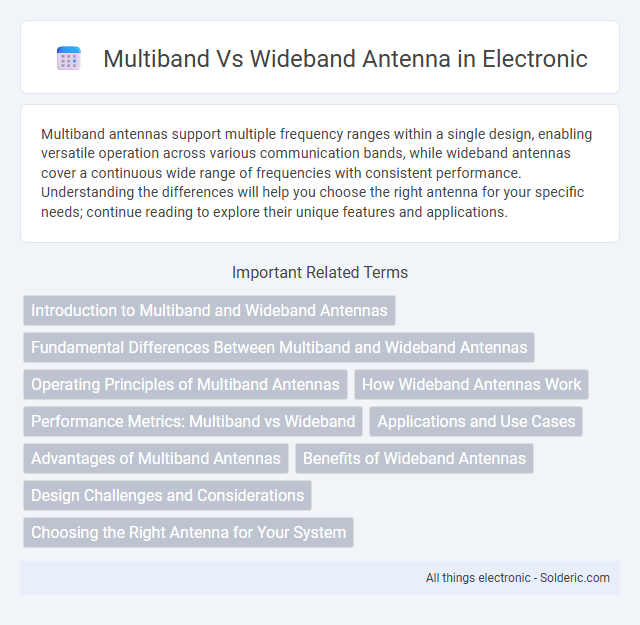Multiband antennas support multiple frequency ranges within a single design, enabling versatile operation across various communication bands, while wideband antennas cover a continuous wide range of frequencies with consistent performance. Understanding the differences will help you choose the right antenna for your specific needs; continue reading to explore their unique features and applications.
Comparison Table
| Feature | Multiband Antenna | Wideband Antenna |
|---|---|---|
| Frequency Coverage | Operates on multiple discrete frequency bands | Operates continuously over a broad frequency range |
| Design Complexity | More complex with tuned elements for each band | Simpler design focusing on broadband performance |
| Performance | Optimized for efficiency and gain on specific bands | Moderate performance across all frequencies |
| Use Cases | Ideal for devices supporting multiple standards (e.g., GSM, LTE) | Suitable for applications requiring wide frequency monitoring |
| Size | Generally compact but can be larger due to multiple elements | Often larger to accommodate wide frequency range |
| Cost | Can be higher due to intricate design | Typically lower due to simpler construction |
| Tuning | Requires tuning for each band | No specific tuning needed |
| Examples | Dual-band Wi-Fi antenna, Tri-band cellular antenna | Log-periodic, Discone antenna |
Introduction to Multiband and Wideband Antennas
Multiband antennas operate across multiple distinct frequency bands, enabling communication with different systems without requiring multiple antennas. Wideband antennas cover a continuous spectrum of frequencies within a broad range, providing extensive frequency coverage with consistent performance. These antenna types are essential in modern wireless applications where versatility and efficient frequency utilization are critical.
Fundamental Differences Between Multiband and Wideband Antennas
Multiband antennas are designed to operate efficiently at specific, discrete frequency bands by incorporating multiple resonant elements tailored to different frequencies. Wideband antennas provide continuous frequency coverage over a broad spectrum by utilizing structures that support a wide range of wavelengths without distinct resonant modes. The fundamental difference lies in multiband antennas targeting multiple narrow frequency bands for optimized performance, whereas wideband antennas emphasize seamless operation across extensive frequency ranges with moderate efficiency.
Operating Principles of Multiband Antennas
Multiband antennas operate by integrating multiple resonant elements or frequency-specific segments within a single structure, allowing efficient transmission and reception over several distinct frequency bands. These antennas use techniques such as multiple radiators, traps, or slot configurations to isolate and optimize each operational band without significant interference. The design ensures that each frequency band resonates independently, providing versatile coverage suitable for applications like cellular communication, amateur radio, and multi-standard wireless devices.
How Wideband Antennas Work
Wideband antennas operate by covering a broad range of frequencies through innovative design elements such as tapered structures, multiple resonators, or fractal shapes that enable efficient signal reception and transmission across diverse frequency bands. Their ability to maintain consistent impedance and radiation patterns over wide frequency ranges results in improved performance for applications requiring versatility, such as military communications and broadband wireless networks. Unlike multiband antennas that switch between discrete frequency bands, wideband antennas continuously support an extensive spectrum, reducing the need for multiple antennas and enhancing signal reliability.
Performance Metrics: Multiband vs Wideband
Multiband antennas excel in targeted frequency performance, offering higher gain and efficiency at specific bands such as VHF, UHF, or cellular frequencies, which benefits applications requiring optimized signal quality. Wideband antennas provide broad frequency coverage with moderate gain, ensuring consistent connectivity across diverse signals like Wi-Fi, LTE, and GPS but may suffer from reduced sensitivity in any single band. Your choice depends on whether precise frequency performance (multiband) or versatile range coverage (wideband) aligns better with your communication needs.
Applications and Use Cases
Multiband antennas excel in applications requiring communication across multiple frequency bands, such as amateur radio, military, and emergency services where versatility is key. Wideband antennas are ideal for systems needing continuous frequency coverage like spectrum monitoring, broadband internet, and radar, offering a broader operational range without retuning. For your needs, choosing between multiband or wideband antennas depends on whether you prioritize frequency flexibility or seamless wide-range performance.
Advantages of Multiband Antennas
Multiband antennas provide the advantage of supporting multiple frequency bands with a single device, reducing the need for multiple antennas and saving space. These antennas enhance your communication system's versatility by allowing seamless switching between different bands without reconfiguration. Their design optimizes performance across diverse frequencies while maintaining compactness and cost efficiency.
Benefits of Wideband Antennas
Wideband antennas offer superior frequency coverage, enabling seamless operation across multiple bands without the need for additional hardware, which simplifies your communication setup. Their ability to handle varying frequencies improves signal reliability and reduces the risk of interference, making them ideal for diverse and dynamic environments. Enhanced performance in signal clarity and range ensures better overall connectivity compared to multiband antennas.
Design Challenges and Considerations
Multiband antennas require intricate tuning and careful impedance matching to operate efficiently across multiple frequency bands, often complicating size and material choices. Wideband antennas face the challenge of maintaining consistent radiation patterns and gain throughout a broad frequency range, demanding advanced design techniques like tapered slot structures or log-periodic elements. Both designs must address trade-offs between bandwidth, efficiency, and physical constraints to meet specific application requirements.
Choosing the Right Antenna for Your System
Selecting the right antenna for your system depends on the specific frequency coverage and performance requirements. Multiband antennas provide the flexibility to operate on multiple distinct frequency bands, making them ideal for systems needing versatility across different communication standards. Wideband antennas offer continuous frequency coverage over a broad spectrum, ensuring consistent signal quality and easier tuning for applications demanding extensive frequency range without switching antennas.
multiband vs wideband antenna Infographic

 solderic.com
solderic.com